How To Use High Wind Ties & Timber Connectors For Timber Projects

Choosing the Right High Wind Ties for Structural Integrity
High Wind Ties play a crucial role in ensuring the structural integrity of timber constructions, especially in areas prone to strong winds. Their function is to provide resistance against uplift forces that can disengage roofs from the rest of the structure.
When selecting High Wind Ties for your timber project, it's essential to consider the type of timber, the structure's exposure to elements, and the local building codes. These ties come in various forms—hurricane ties, truss clips, and hold-downs—each engineered for different applications. For heavier timber applications, pairing them with the right Connectors for Glulam Timber ensures your design is robust and safe. Proper selection and positioning enhance both the safety and the durability of the entire build.
Timber Connector Options for Extreme Weather Conditions
Timber connectors are essential not only for joining timber elements but also for reinforcing their connections against environmental stress. In high wind zones, standard fixtures often fall short, making specialized connectors a necessity.
High-performance timber connectors are designed to resist torsion, shear, and axial forces caused by sustained wind pressure. For cross-laminated or glulam timber, it's crucial to choose connectors that correspond to the bulk and orientation of engineered wood members. Products from the Connectors for cross laminated timber range offer enhanced resistance and compatibility for such structural builds. By integrating robust connectors, your timber frame gains the reinforcement it needs to stand resilient in adverse weather conditions.
In many cases, these systems are paired with restraint mechanisms to add another layer of safety against shifting or uplifting. These components interact with various connection points of the timber framework and often work in tandem with Restraint Straps to mitigate movement caused by wind loads.
Positioning and Installation Best Practices
Proper positioning of High Wind Ties and timber connectors is vital. Even the best materials can fail if poorly installed.
High Wind Ties should be installed according to manufacturer guidelines, with precise alignment to rafters, joists, or studs. Pay careful attention to nailing schedules, which are often overlooked but crucial for performance under high-stress conditions. Structures located near coastlines or open landscapes should follow tighter spacing and additional anchoring techniques to secure framing members.
Use compatible materials when combining ties, connectors, and fasteners to avoid galvanic corrosion. Moreover, integrating connectors with Joist Hangers helps maintain superior load distribution across floors and ceiling levels, ensuring the configuration resists not just wind but also foot traffic and furniture loads. Double-checking load path continuity and installation torque also boosts the reliability of the entire framework.
Corrosion Protection and Longevity
Outdoor timber structures exposed to persistent moisture need connectors that can resist corrosion. Wind loads add additional dynamic stress, magnifying any degradation of metal integrity.
Choosing galvanised or stainless steel High Wind Ties ensures long-lasting performance, especially when the timber is treated or located near saltwater. A protective finish extends service life, reducing the need for frequent replacements or repairs. It is also wise to examine connectors annually, tightening any loosened fasteners and replacing corroded units promptly.
In addition to using metal ties with protective coatings, designers should consider drainage, ventilation, and sealing materials in the area of connection. This further prolongs the life of both the timber and the connectors by minimizing moisture entrapment and enhancing air flow at joints.
Integrating Various Connectors in Timber Projects
A comprehensive timber build will include multiple types of connectors working together for overall performance. High Wind Ties act as part of a larger system of connectors and are more effective when integrated with complementary parts.
For instance, when anchoring vertical and horizontal structural elements, combining Post Base components with High Wind Ties creates a full-spectrum reinforcement. This synergy distributes loads and stresses across the framework, protecting vulnerable points from collapse or shifting.
Modern timber architecture, especially using engineered wood products like glulam and CLT, demands harmonized hardware systems. Making informed selections from dedicated categories like High Wind ties & timber connectors offers both flexibility and reliability. When used strategically, all these elements contribute to a durable, high-performing timber structure capable of withstanding high wind pressures and forces over the long term.
